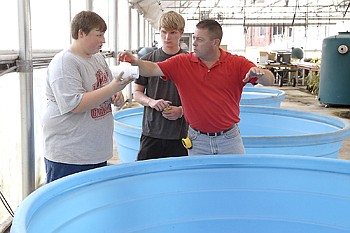SECTION, Ala. - While most folks use bait to catch fish, Section High School is using fish as bait to catch students.
With fish farming as a lure, a new program at the school has students using biology, math and science skills to raise tilapia. Learning and hands-on activities land in the same boat.
Students are learning to feed the fish, balance acidity and to build and maintain the operation, said Slade Bellomy, who teaches aquaculture - the technical word for fish farming - and agricultural science at the school.
"This is a working lab," he said, standing by a tank swirling with tilapia that have grown to as large as two pounds since last November.
In the school's greenhouse, Bellomy shows off a hatchery tank, a 300-gallon viewing tank, two operating 450-gallon grow-out tanks, and four new 700-gallon tanks he and students are installing.
And that's just the beginning.
Welding students are building steel frames for two 22-foot long, 4-foot deep, 5,000-gallon indoor "ponds" where growing tilapia can live in floating mesh baskets while the rest of the tanks can hold freshwater shrimp or crawfish, Bellomy said.
Right now the program is in the formative stages, but once enough tilapia and other aquatic animals are raised, they can be sold to restaurants and other businesses or used in fish-fry fundraisers to help sustain the operation, he said.
Even the nutrient-rich "fish water" sold to area farmers as fertilizer, something the school is already doing. After being pumped out of the tanks and filtered, the water is piped to other parts of the greenhouse to water some of the plants and Bellomy brags that fish water outperforms the commercial fertilizers used for years in the greenhouse.
The operation also extends the experience to elementary and middle school students, who come to learn about fish, aquatic farming and interdependency of ecological systems, he said.
Standing around a 450-gallon tank filled with almost 100 hand-sized tilapia, seniors Steven Myers, Jacob Bradford and Tyler Gant predicted that the new program will attract plenty of Section High students.
While they won't be around long enough to take full advantage of the program, younger students will have time make the most of it over the years, they said.
Students "can learn about taking care of the fish in fish hatcheries," said Myers, 18, and some students may even be inspired enough to make a career in fish farming,
"It's a fun thing to do at school," said 17-year-old Jacob.
Future fish
The program launched last year, but help from the South Alabama-based nonprofit Program for the Academic and Cultural Enhancement of Rural Schools, or PACERS, pushed the project well-ahead of where it would be on its own, Bellomy said.
PACERS helps develop aquaculture and other programs at schools across Alabama, providing professional consultants, workshops, teacher support and training, according to Bellomy and the organization's website, pacersinc.org.
TILAPIAFemale tilapia lay eggs in a simple nest, the male fertilizes them and the female picks up the eggs and incubates them in her mouth. Once the young fish are free swimming, they will return to her mouth for protection. Females can produce several hundred to several thousand young in each spawning, and the high degree of parental care allows breeders to quickly produce many generations in the same amount of time it takes other fish species to mature.Source: University of Arizona and the American Tilapia Association
Section High only invested about $500 in the program, but the equipment that PACERS helped provide likely saved as much as $14,000, Bellomy figured.
Section principal Steve Durham said the program has even wider potential than just the school system. It can change and invigorate the community over the next few years, he said.
"It's a community-based project, not just a schools project," Durham said.
The skills students learn to apply through the program "shows how science and business can go hand in hand," he said.
With that in mind, Jackson County Schools purchased property adjacent to the greenhouse to give the agriculture area room to grow, he said. The property has room for large outdoor ponds, a garden spot, fruit trees and animals, he said, with the ponds planned for the eventual addition of striped bass and catfish to the operation.
In a time when farms often are single-plant or single-animal operations, local farmers may be able draw ideas by seeing how the school's diversified crops benefit each other, Durham said.
